Spring 2019 Projects
Coastal Cultures for the Elementary Learner
Faculty: Geoffrey Fouad, GIS Program, with Communications graduate student and Production Services Director Erin Fleming
Videos, graphics and other content will be developed for an educational story map geared toward elementary school students that explores the differences and similarities in coastal cultures around the world.
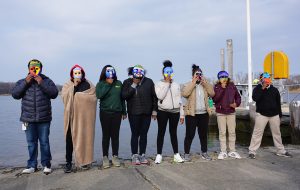 Development of an Art & Ecology Residency Experience for Monmouth Students at Joya, Velez-Blanco, Spain
Development of an Art & Ecology Residency Experience for Monmouth Students at Joya, Velez-Blanco, Spain
Faculty: Kimberly Callas, Dept. of Art and Design
Callas will continue to build on her nature-inspired Discovering the Ecological Self project through an arts residency at Spain’s Joya: arte + ecología.
Using Fractal Patterning to Explore the Coastline and the Human Body
Faculty: Karen Pesce, Dept. of Biology, and Sandra Zak, Dept. of Mathematics
Funding will support the development of an interdisciplinary curriculum module focused on the study of fractal patterns in nature, including in coastal environments.
Integrating Calligraphy into Interactive Design Curriculum Focused on Coastal Challenges
Faculty: Jing Zhou, Dept. of Art and Design
Tools and supplies will be purchased for students creating calligraphy art focused on phrases that reflect environmental and societal challenges in coastal regions.
Panel Chair and Presentation at 44th Annual Caribbean Studies Association Conference
Faculty: Paul Humphrey, Dept. of World Languages and Cultures
Humphrey will lead a panel discussion that explores how the sea unites and divides Caribbean cultures in literature.
Spring 2018 Projects
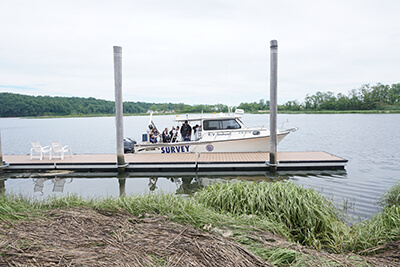
Aerial Drone Applications in Environmental Mapping and Education
Faculty Lead: Dr. Geoffrey Fouad, Dept. of History and Anthropology, with UCI Marine Scientist Jim Nickels; Dr. Richard Veit, Dept. of History and Anthropology; Dr. Pedram Daneshgar, Dept. of Biology; and UCI Associate Director Dr. Thomas Herrington
Aerial drone images will be captured from multiple altitudes to help visualize the topography of marsh and maritime forest areas near the Monmouth Marine and Environmental Field Station in Rumson, conduct beach surveys, and monitor archaeology sites. The project will use the drone to continuously sample dynamic coastal areas and develop innovative processing and visualization methods to analyze the data.
Cyanobacterial Harmful Algal Blooms in New Jersey Coastal Lakes: An Experimental Assessment of Deal Lake in Monmouth County
Faculty Lead: Dr. Jason Adolf, Dept. of Biology
This grant will be used to purchase equipment for Dr. Adolf to research factors that have resulted in a recent expansion of harmful algal blooms in coastal lakes. The equipment will be used by Dr. Adolf’s Ecosystems Analysis class to analyze plankton populations and water quality at Deal Lake over time and to better understand nutrient conditions that favor the onset of these events.
Discovering the Ecological Self
and
Assessing Student Outcomes of Discovering the Ecological Self
Faculty Leads: Kimberley Callas, Dept. of Art and Design, and Dr. Megan Delaney, Dept. of Professional Counseling; with Dr. Pedram Daneshgar, Dept. of Biology
In this two-prong project, Professor Callas will work with students from the Aslan Youth Ministry to create 3-D printed mask artwork inspired by local beach environments and reflections on what that environment means to them. Dr. Delaney will explore whether the students’ immersion in art and nature changed their perspectives on coastal stewardship.
Disappearing Cattails: Documentary Video Project
Faculty Lead: Dickie Cox, Dept. of Communication, with Dr. Pedram Daneshgar, Dept. of Biology
Students will create a documentary that shows Jersey Shore cattails to be emblematic of the global problem of invasive species disrupting coastal ecosystems. The film will highlight Dr. Daneshgar’s research of how invasive reeds (phragmites) are displacing cattails along local waterfront habitats and will be submitted to a number of regional and science-based film festivals.
Establishing A Gillnet Survey to Examine Population Demographics of Atlantic Sturgeon within the Restricted Waterways of Naval Station Earle and Sandy Hook Bay
Faculty Lead: Dr. Keith Dunton, Dept. of Biology
Dr. Dunton will expand upon previous UCI-funded research on the populations and behaviors of the endangered Atlantic sturgeon in area waterways. Prior research has focused on monitoring tagged Atlantic Sturgeon with underwater acoustic receivers. The present research will provide a better estimate of the present Sturgeon population by sampling tagged and untagged fish through gillnet surveys.
Impact of Interdisciplinary Team Teaching on Development of Student Critical Thinking Skills
Faculty Lead: Dr. Heide Estes, Dept. of English, with School of Science Associate Dean Dr. Catherine Duckett
The funding will provide partial support for an ongoing assessment of how students respond to a team of teachers representing separate areas of expertise while completing a course that explores the topic of climate science from the perspectives of biology and literary studies. The research will determine if interdisciplinary team teaching improves students’ critical thinking, sense of environmental value and civic engagement.
Using Population Genetics to Inform Management of New Jersey Fisheries
Faculty Lead: Dr. Megan Phifer-Rixey, Dept. of Biology, with School of Science Assistant Dean John Tiedemann
The funding will support efforts by the Marine and Environmental Biology and Policy Program to determine the region(s) of origin for striped bass in northern Ocean County, and estimate the historic population sizes of Atlantic sturgeon through genetic data analysis. DNA collected from the stripers and sturgeon will be analyzed to provide estimates of population size, help identify distinct fish population segments relevant for conservation, and provide other information regarding diversity within and among populations.
What Lies Beneath?
Faculty Lead: Dr. Richard Veit, Dept. of History and Anthropology, with UCI Marine Scientist Jim Nickels
New Jersey shipwreck information and artifacts available in local museums and other repositories will be inventoried for Dr. Veit and Nickels’ Underwater Archaeology course.
Summer 2017 Projects
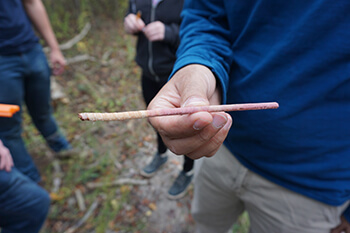 Impacts of Salt on Juvenile Trees of New Jersey Maritime Forests: Continuing research begun in the fall of 2016, the team studied tree core samples from Jersey Shore maritime forests to analyze their ring patterns, which can serve as indicators of rising atmospheric CO2, annual climate and major storm events.
Impacts of Salt on Juvenile Trees of New Jersey Maritime Forests: Continuing research begun in the fall of 2016, the team studied tree core samples from Jersey Shore maritime forests to analyze their ring patterns, which can serve as indicators of rising atmospheric CO2, annual climate and major storm events.
Students:
Jeff Dudek, Kelsey Connelly and Matthew Francis
Faculty/Staff:
Dr. Pedram Daneshgar, Department of Biology
Assessing Coastal Lakes in Monmouth County:
Participants conducted water quality monitoring, sediment sampling, hydrographic surveys (depth and debris mapping) and other research at sites including Lake Como, Lake Takanassee, Franklin Lake, Wesley Lake and Sunset Lake.
Students:
Erin Conlon and Daniel Gerdon
Faculty/Staff:
UCI Marine Scientist Jim Nickels
Assessment and Inventory of New Jersey Coastal Fisheries:
The team analyzed New Jersey Department of Environmental Protection trawl survey data for elasmobranch species (skates, rays, sharks, etc.) for the development of GIS map products and conduct sampling in coastal waters to inventory species in the area.
Students:
Gina Badlowski, Jarius Bradley and Marissa DeTorre
Faculty/Staff:
Dr. Keith Dunton, Department of Biology
Evaluating Essential Finfish Habitat and Movements within the Leased New York Wind Energy Area (Faculty Enrichment Grant):
Fish species in the federally designated offshore wind energy lease area outside of Lower New York Bay were tagged to gather information on both recreational and commercial species of concern in the area.
Faculty/Staff:
Dr. Keith Dunton, Department of Biology
Exploring the factors that affect Juvenile Tree Growth and survival in a Maritime Forest (Faculty Enrichment Grant):
A series of greenhouse and field experiments provided insight into how juvenile trees respond to environmental stresses that occur in coastal ecosystems.
Faculty/Staff:
Dr. Pedram Daneshgar, Department of Biology
Students
: Jeff Dudek, Kelsey Connelly and Matthew Francis
Hydrology Research Publication (Faculty Mini-Grant):
A faculty mini-grant funded the publication of research on a GIS tool being developed to predict stream flows in watersheds in the journal
Hydrology and Earth System Sciences.
Faculty/Staff:
Dr. Geoffrey Fouad, Department of History & Anthropology
Locally Based Mathematical Modeling (Faculty Enrichment Grant):
The grant facilitated the development of modules for MA 115 (Precalculus Modelling in the Biological Sciences) that apply modeling techniques to research questions related to local water bodies.
Faculty/Staff:
Dr. Joseph Coyle, Department of Mathematics
Monmouth/Ocean Coastal Community Database:
Two graduate assistantships were funded to create a database that includes a wealth of information on the economy, health, history, education, environment and more in Jersey Shore communities.
Students:
Christopher McKenna and Zahra Yaramadi
Faculty/Staff:
Dr. Susan Forquer Gupta, Department of Marketing & International Business
Fall 2016 Projects
 Faculty Enrichment Grants were approved for these efforts in the fall 2016 semester.
Faculty Enrichment Grants were approved for these efforts in the fall 2016 semester.
Curriculum Development – Statistical Design and Analysis of Biological Experiments: The Departments of Mathematics and Biology introduced a new course that focused on the impacts of climate change on coastal forests. The class used equipment purchased through the UCI to extract tree cores in Sandy Hook and Island Beach State Park and analyze their ring patterns, which can serve as indicators of rising atmospheric CO2, annual climate and major storm events.
Faculty Members: Dr. Richard Bastian, Department of Mathematics, and Dr. Pedram Daneshgar, Department of Biology
Evaluating Habitat Use of Atlantic Sturgeon Around Naval Weapon Station Earle: Building on his summer research of this endangered species in Sandy Hook Bay, Dr. Keith Dunton received permission to attach acoustic receiver equipment to U.S. Navy buoys in order to detect sturgeon activity in the federally restricted area.
Faculty Member: Dr. Keith Dunton, Department of Biology, in coordination with student researcher Jeffery Webb
Integrating Emerging Technological Tools of Fisheries Science into the Classroom: UCI funding was used to purchase acoustic telemetry equipment, a means for accurately monitoring the movements and activities of marine species. The equipment will be used in two biology classes in the fall.
Faculty Members: Dr. Keith Dunton, Department of Biology, and UCI Marine Scientist Jim Nickels
Tracing Nitrogen Deposition Affects on Salt Marshes Using Nitrogen Isotopes: This project continued work begun in the summer to test areas along the Long Island and New Jersey coasts to determine the impacts of human-sourced nitrogen deposition on salt marshes.
Faculty Member: Dr. Pedram Daneshgar, Department of Biology, in coordination with student researcher Cayla Sullivan
Walkability and Bikeability of the Jersey Shore: The research team surveyed Monmouth County’s transportation network to assess its bicycle and pedestrian friendliness, and analyze existing local government policies that may influence infrastructure investment decisions in the future.
Faculty Members: Dr. James Konopack, Department of Health and Physical Education, and Dr. Stephen Chapman, Department of Political Science and Sociology
Summer 2016 Projects
Abstracts for these projects are available in the 2016 Monmouth University School of Science Summer Research Program Symposium guidebook and a second booklet featuring additional UCI projects.
 Environmental DNA (eDNA) in Wreck Pond: Continuing an effort that began in the spring, the team researched the presence of marine vertebrates in the Wreck Pond watershed using eDNA, an emerging approach that allows scientists to detect endangered or hard to find marine organisms without having to observe or capture them.
Environmental DNA (eDNA) in Wreck Pond: Continuing an effort that began in the spring, the team researched the presence of marine vertebrates in the Wreck Pond watershed using eDNA, an emerging approach that allows scientists to detect endangered or hard to find marine organisms without having to observe or capture them.
Student Researchers: Tatiana Castro, Chelsea Soriano and Cayla Sullivan
Faculty Mentor: Dr. Christine Thompson, Adjunct Professor, Department of Biology, and Dr. Tiffany Medley, Lecturer, Department of Biology
Assessment of Vertebrate and Microbial Diversity in Local Ecosystems using Environmental DNA (eDNA): In this second eDNA research project, students detected the presence and abundance of vertebrate, microbial and viral eDNA in Long Branch’s Lake Takanassee.
Student Researchers: Nicole Sivetz, Sarah Falotico and Hemangi Patel
Faculty Mentor: Dr. Martin J. Hicks, Assistant Professor, Department of Biology
The National Flood Insurance Program Community Rating System (CRS): The study investigated the reasons and rationale for Ocean County communities’ membership in Community Rating System/National Flood Insurance programs to better understand which facets serve as an impetus and which hinder and incentivize participation. The benefits and drawbacks revealed in interviews with Ocean County officials will be useful to other communities that may be considering joining the CRS program.
Student Researchers: Albert Shalom and David Morales
Faculty Mentor: Dr. Michael Schwebel, UCI Community Resilience and Climate Adaptation Specialist
Oyster Restoration in Barnegat Bay: Students worked alongside the American Littoral Society, ReClam the Bay, and other partners while examining the abundance and diversity of oysters around an artificial reef that was installed off Good Luck Point with UCI/Monmouth University assistance.
Student Researchers: Gabriella A. Gerber, Sydney N. Lucas and Cameron S. McMath
Faculty Mentors: Dr. Christine Thompson, Adjunct Professor, Department of Biology, and Dr. Tiffany Medley, Lecturer, Department of Biology
Coastal Aerial Photography Photography & Video: With the support of a mini-grant, Professor Mark Ludak conducted aerial photography of coastal New Jersey aboard a helicopter with student assistance.
Project Leader: Mark Ludak, Specialist Professor, Department of Art and Design
Spring 2016 Projects
Automatic System for Collection of Physico-Chemical Parameters of Water for Assessment of Intertidal Coastal Ecosystems: This project created a system to collect water salinity and temperature data at mangroves in the Bahamas, with the goal of modeling how the mangroves respond to the impacts of climate change.
Project leaders: Dr. Dmytro Kosenkov, Assistant Professor, Department of Chemistry and Physics; and Dr. Pedram Daneshgar, Assistant Professor, Department of
Biology
Evaluating the Potential Habitat Use of the Endangered Atlantic Sturgeon in Sandy Hook Bay: Acoustic telemetry technology was used to monitor the presence and behaviors of tagged fish in the bay’s inshore waters.
Project leader: Dr. Keith Dunton, Assistant Professor, Department of Biology
Understanding the Physiology and Behavior of Angled and Air-Exposed Striped Bass Using a Rapid Assessment Approach: This project built upon previously funded work to develop science-based best practices for the catch and release of Atlantic striped bass.
Project leader: School of Science Interim Dean John Tiedemann
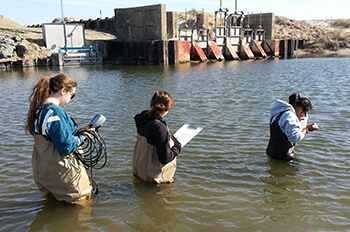 eDNA Laboratory Protocols and Wreck Pond Sampling Project: In a collaboration with Rockefeller University, samples were collected from the Sea Girt/Spring Lake area waterway and tested for the presence of marine life using cutting-edge environmental DNA (eDNA) technology.
eDNA Laboratory Protocols and Wreck Pond Sampling Project: In a collaboration with Rockefeller University, samples were collected from the Sea Girt/Spring Lake area waterway and tested for the presence of marine life using cutting-edge environmental DNA (eDNA) technology.
Project leaders: Dr. Christine Thompson, Adjunct Professor, Department of Biology; and
Dr. Martin Hicks, Assistant Professor, Department of Biology
Class Magazine Mini-Grant: An online publishing service was used to create a magazine for environmental chemistry students to share their views on current issues in the field.
Project leader: Dr. Shirley Crenshaw, Instructor, Department of Chemistry and Physics
Hands-on foldscope Demonstration at the National Science Teachers Association Conference Mini-Grant: This grant allowed a student to give a presentation on her UCI-funded 2015 summer research on the use of paper-based microscopes at a conference in Nashville, Tennessee.
Faculty Mentor: Dr. Judith Bazler, Professor, School of Education
Coastal New Jersey Small Business Website Graduate Assistantship: A graduate assistantship was granted to Morissa Schwartz to develop
CoastalNJSmallBusiness.com, a website that highlights eco-friendly businesses in Jersey Shore area coastal downtowns.
Faculty Mentor: Dr. Deanna Shoemaker, Director, Corporate & Public Communication (CPC) Graduate Program
Summer 2015 Projects
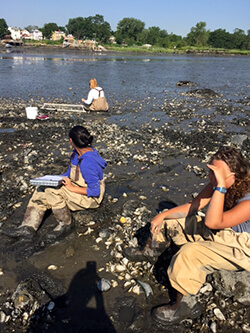
Characteristics of Eastern Oyster (Crassostrea Virginica) Populations in the Upper East River, N.Y.
Student Researchers: Megan O’Donnell, Amanpreet S. Singh, Chelsea Soriano and Rebecca Klee
Faculty Mentor: Dr. Tiffany Medley, Monmouth University Department of Biology
This project assessed oyster populations on the waterway’s Bronx side, where overfishing and pollution once caused their numbers to dwindle.
Read Characteristics of Eastern Oyster abstract
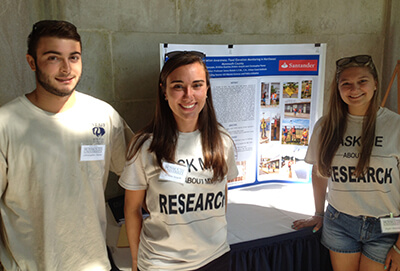
Creating Inundation Awareness: Flood Elevation Monitoring in Northeast Monmouth County
Student Researchers: Taylor Donovan, Kristina Guarino, Kristen Jezycki and Christopher Paone
Faculty Mentor: Professor James Nickels, Urban Coast Institute
In the summer of 2015, the research team worked with communities in the Raritan Bayshore area to delineate the high water marks during Superstorm Sandy.
Read Creating Inundation Awareness abstract
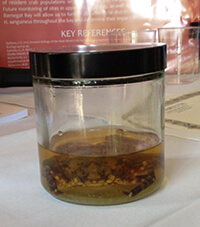
Is the Invasive Asian Shore Crab (Hemigrapsus
Sanguineus) Expanding into Upper Barnegat Bay?
Student Researchers: Emily Cristiano, Kylie Johnson, Kristen Ranges (University of Delaware) and Jeffrey Webb
Faculty Mentor: Dean John A. Tiedemann, Department of Biology
The project investigated whether the invasive Asian shore crab had expanded into the vicinity of Bay Head and Mantoloking in the Barnegat Bay.
Read Invasive Asian Shore Crab abstract
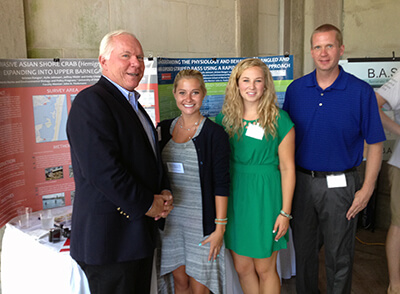
Understanding the Physiology and Behavior of Angled and Air-Exposed Striped Bass Using a Rapid Assessment Approach
Student Researchers: Emily Cristiano, Kylie Johnson, Kristen Ranges and Jeffrey Webb
Faculty Mentor: Dean John A. Tiedemann, Department of Biology
This project produced information that could help develop recommendations for the maximum time recreational fishermen can remove angled striped bass from water if they intend to safely release them.
